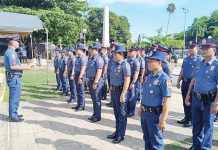[av_one_full first min_height=” vertical_alignment=” space=” custom_margin=” margin=’0px’ padding=’0px’ border=” border_color=” radius=’0px’ background_color=” src=” background_position=’top left’ background_repeat=’no-repeat’ animation=”]
[av_heading heading=’ Archdiocese of Jaro challenges ‘shabulized’ tag ‘ tag=’h3′ style=’blockquote modern-quote’ size=’30’ subheading_active=’subheading_below’ subheading_size=’15’ padding=’10’ color=” custom_font=”]
BY GLENDA SOLOGASTOA
[/av_heading]
[av_textblock size=” font_color=” color=”]
Monday. September 25, 2017
[/av_textblock]
[av_textblock size=” font_color=” color=”]
ILOILO City – Davao’s problem on illegal drugs is far worse than Iloilo’s so why tag Iloilo, city or province, the “most shabulized” in the country and “bedrock” of illegal drugs, asked Monsignor Meliton Oso, director of the Archdiocese of Jaro’s Social Action Center.
The archdiocese has launched a signature campaign contesting, among others, President Rodrigo Duterte’s tag on Iloilo.
This “appeal to conscience and action based on truth” is an information and education campaign, too, said Oso, to counter the President’s “biased” tagging of Iloilo.
“Pirmi lang ‘ya Iloilo…iya na ‘ya biased ukon kon ano man da nga indi ‘ya magustohan sa Iloilo,” said Oso.
While the drug problem could not be denied, the archdiocese said “it is important to also raise the questions about the credibility of sources, the genuineness of the data gathered…and the integrity of the process of verification.”
In Aug. 7, 2016 “most shabu-lized” was how President Duterte described Iloilo, not specifying if he was referring to the city or province, as he linked four mayors, including this city’s Jed Patrick Mabilog and several police officers to illegal drugs.
“Iloilo grabe talaga,” said Duterte as he ordered the Philippine National Police to remove from these mayors the power to supervise their police units.
But Duterte did not provide further evidence to back his claim apart from his narco-list. When he was criticized for making public the names, he insisted the list went through a verification process.
Then on June 28 this year, he dubbed Iloilo “bedrock” of illegal drugs.
“I had an occasion to say it in public that it was Iloilo who (sic) was the bedrock of…kasi doon dinadaan e,” said Duterte whose campaign promise during the 2016 elections was to eradicate criminality and illegal drugs. “Then (illegal drugs) spread to the Visayas.”
Oso urged Ilonggos to join the signature campaign, even non-Catholics.
“We want Ilonggos to speak out through the signature campaign. We want to tell the President nga ari hu, wala kami ‘ya gapati. Ikaw man lang ang nagapati,” Oso told Panay News.
The signature campaign started on Sept. 20. All parishes in the city and province of Iloilo have until Oct. 20 to gather signatures down to the barangays. Once done, these will be sent to the President.
According to the archdiocese, even Philippine National Police director general Ronald Dela Rosa declared in a local radio that “Iloilo is not that bad when it comes to the drug problem.”
“It is interesting that even Philippine Drug Enforcement Agency’s statistical data of drug problematic areas show that Iloilo City was 51st and the province was 79th whereas in contrast, Davao City was ranked 20th in the country,” the archdiocese added.
For the local church, “public shaming and threats are not the right way to move forward in addressing the problem.”
Friday last week, Sept. 22, the President urged the Church to help in the drug war and not just criticize.
According to the President, he was planning to give his narco-list to priests and bishops so they could talk to these drug personalities and ask them to stop their illegal activities.
Catholic churchmen could do this as a “preemptive move” to something dire that could happen if these drug personalities continue with their activities, he explained.
In August last year a few days after Duterte tagged Iloilo “most shabulized”, VERA Files, a non-stock, nonprofit independent media organization, came out with a report fact-checking the President.
Here’s a portion of that VERA Files report:
“If Duterte meant Iloilo as the province or city where the use of shabu or methamphetamine hydrochloride is most prevalent, data from the Philippine Drug Enforcement Agency (PDEA) fail to directly coincide with the President’s claim.
“Of the 81 provinces and 27 cities listed by PDEA from January to August 2016, Iloilo province ranked only 79th in terms of the number of drug-affected barangays per province, while Iloilo City ranked 51st.
“The top 10 cities with the highest number of drug-affected barangays are located in the National Capital Region (NCR), consistent with earlier PDEA reports.
“In 2015, PDEA pegged the number of drug-affected barangays in NCR at 99.26 percent, stating that of the 1,706 barangays in the country, 1,574 are affected by drugs.
“A quick check on the figure, however, showed it was miscalculated: the percentage of drug-affected barangays in the country in 2015 should only be 92.26 percent, 7 percentage points lower than the original.
“By August 2016, the number increased, with 1,577 of the 1,706 barangays now affected by drugs.
“The Dangerous Drugs Board considers an area affected by drugs if there is a drug user, pusher, drug personality, manufacturer, drug den, or clandestine drug laboratory there.
“Meanwhile, Cebu has the highest number of drug personalities arrested, at 2,071, and high value targets, at 78.
“Iloilo, on the other hand, ranked 10th with 344 drug personalities arrested, while Iloilo City ranked second in the provinces and cities with the most number of high-value targets.
“Figures also showed that as of August 2016, a total of five clandestine laboratories found in Pampanga, Las Piñas, Manila, and Zambales have been dismantled.
“In their 2015 annual report, PDEA recorded a total of 92 dismantled shabu laboratories from 2002 to 2015, most of which were discovered in the areas of Central Luzon and NCR.
“Of the 92 shabu laboratories, 48.9 percent were found in NCR, while 17.4 percent were located in Central Luzon.
“Next to NCR, however, was Region 4A, with 17 shabu laboratories.
“As for the highest number of dismantled drug dens, Agusan del Norte ranked first, followed by Iloilo City and Iloilo.”/PN
[/av_textblock]
[/av_one_full]



